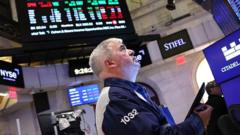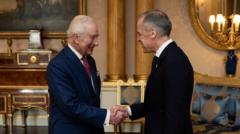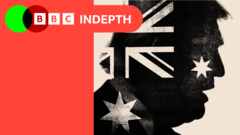President Trump has successfully negotiated a temporary delay on tariffs with neighboring countries while implementing a new tariff on China, revealing the complexities of his trade policies.
Trump Strikes Trade Deals to Delay Tariffs on Canada and Mexico

Trump Strikes Trade Deals to Delay Tariffs on Canada and Mexico
President negotiates with Canada and Mexico while tensions rise with China
As of February 4, 2025, President Donald Trump has reached last-minute agreements with Mexican President Claudia Sheinbaum and Canadian Prime Minister Justin Trudeau to postpone tariffs on goods exported to the U.S. for 30 days, shortly after a 10 percent tariff on Chinese products took effect. This frenzied series of negotiations underscores Trump’s approach of leveraging tariffs to address issues like drug smuggling and illegal immigration — a method that impacts over a third of U.S. imports sourced from Mexico, Canada, and China.
In response to the newly imposed tariffs, China is reportedly analyzing its options, observing Trump’s “America First” strategy closely. This can imply both opportunities and challenges for Beijing, as they seek to reassess their relationship with estranged American allies. During an interview, Trump distinctly hinted at upcoming tariffs against the European Union, specifically mentioning trade imbalances related to automotive and agricultural exports.
In a broader context, Trump’s aggressive stance on trade is seen by some economists as a double-edged sword, balancing potential economic boosts against possible setbacks. Beyond trade, Trump’s administration is facing heightened scrutiny, with ongoing developments including Musk’s controversial influence over U.S. aid agencies, political protests, and heated debates in Congress regarding various policies and administrative actions, as the landscape of American governance continues to evolve.
In response to the newly imposed tariffs, China is reportedly analyzing its options, observing Trump’s “America First” strategy closely. This can imply both opportunities and challenges for Beijing, as they seek to reassess their relationship with estranged American allies. During an interview, Trump distinctly hinted at upcoming tariffs against the European Union, specifically mentioning trade imbalances related to automotive and agricultural exports.
In a broader context, Trump’s aggressive stance on trade is seen by some economists as a double-edged sword, balancing potential economic boosts against possible setbacks. Beyond trade, Trump’s administration is facing heightened scrutiny, with ongoing developments including Musk’s controversial influence over U.S. aid agencies, political protests, and heated debates in Congress regarding various policies and administrative actions, as the landscape of American governance continues to evolve.






















